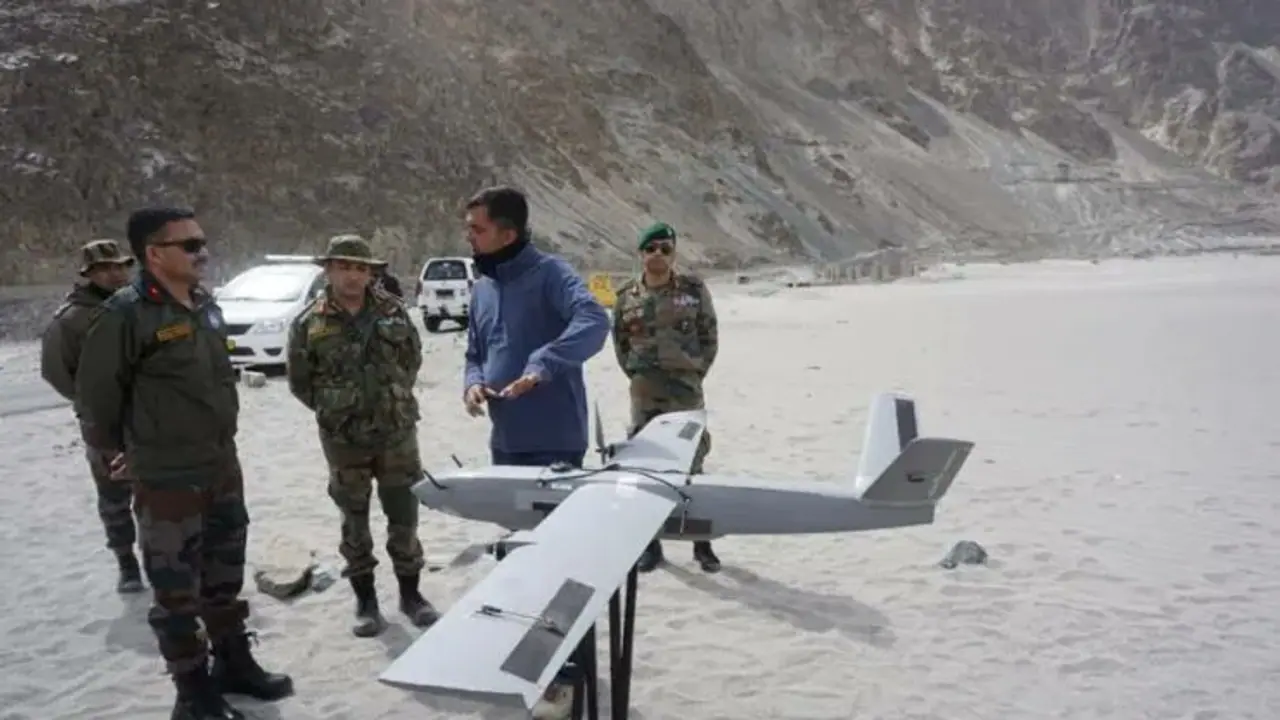The contours of modern warfare are rapidly shifting from conventional engagements to networked, high-precision, and technology-enabled operations.
(Cover image for representational purposes only)

The contours of modern warfare are rapidly shifting from conventional engagements to networked, high-precision, and technology-enabled operations. At the forefront of this transformation lies the disruptive promise of Autonomous Surveillance and Armed Drone Swarms (A-SADS), a class of systems that is reshaping tactical doctrines, redefining battlefield dominance, and heralding a new era of asymmetric advantage. In India's context, especially along the volatile northern and western frontiers, the Indian Army's strategic embrace of A-SADS reflects both realism and foresight, embedding these systems into the Army’s future force architecture.
The Indian Army's “Decade of Transformation (2023–2032)” envisions the absorption of cutting-edge technologies, ranging from artificial intelligence and robotics to loitering munitions and swarm drones, as part of its modernisation doctrine. Drone warfare, once an experimental domain, has proven its decisive utility in recent conflicts from Nagorno-Karabakh to Ukraine. Using small, agile, and low-cost drone swarms to neutralise expensive platforms has challenged the cost-risk calculus of legacy militaries. A-SADS, particularly when integrated with Artificial Intelligence (AI) based Intelligence, Surveillance and Reconnaissance (ISR), are now central to warfighting.
The Indian Army has taken serious cognisance of this shift. AI and ISR are niche tech areas. The future-ready force is conscious of leveraging these technologies to enhance situational awareness, faster decision-making, and greater precision in combat. This geographical specialisation ensures that swarm drones are optimised for extreme climatic conditions, terrain challenges, and adversary profiles. The systems are intended not just for surveillance but also for precision strike missions, logistical resupply, and rapid response engagements, all while operating autonomously or semi-autonomously in contested airspaces.
The A-SADS initiative is reinforced by the Army’s procurement plans for Canister-Launched Anti-Armour Loitering Munitions (CALM)—with 45 systems contracted in September 2023 and deliveries scheduled by 2025. Unlike traditional drones, loitering munitions blend the qualities of UAVs and missiles, offering prolonged surveillance followed by a terminal attack on high-value targets such as enemy armoured columns or radar installations.
Simultaneously, the Indian Army is integrating 363 logistics drones, with 163 under delivery and rest in procurement pipeline. These are envisioned to drastically reduce dependency on vulnerable and manpower-intensive supply lines, especially in forward areas like Siachen or Arunachal Pradesh. Their silent mobility and real-time connectivity enhance survivability and sustainability in high-altitude warfare.
What makes A-SADS revolutionary is their swarming capability, multiple drones operating as a cohesive unit without human control, powered by AI. Swarms can autonomously distribute tasks, adapt to changing battlefield dynamics, and overwhelm enemy air defences through distributed lethality. An individual drone might be expendable, but a swarm achieves mission assurance through numerical superiority and cooperative engagement tactics.
The Indian Army’s approach goes beyond mere hardware acquisition. The establishment of Army cells at the Indian Institute of Technology Delhi (IIT-D), the Indian Institute of Technology Kanpur (IIT-K), and the Indian Institute of Science (IISc) Bengaluru, along with 16 technological clusters, signals a structural pivot to absorb AI, machine learning, and advanced materials into indigenous drone platforms. Over 50 AI-powered defence projects are underway, with key thrusts in target recognition, predictive analysis, and ISR fusion. These enable the transformation of drones from “flying cameras” into autonomous decision-making assets with strategic consequences.
Moreover, India is not operating in isolation. The procurement of Heron Mk-II RPAS, Hermes Starliner MALE drones, and the anticipated induction of MQ-9B Predator HALE drones by 2029–30 positions India at par with drone-dominant global militaries. The Predators, acquired in a tri-service contract, are slated to offer a formidable strategic ISR and precision strike capability deep within enemy territory.
From a strategic standpoint, the Indian Army’s embrace of A-SADS addresses two core concerns: deterrence through disruption and asymmetry in a numerically constrained force structure. Against a technologically advanced and numerically superior adversary like China, drone swarms offer a cost-effective means to impose disproportionate attrition, delay enemy mobilisation, and complicate their operational calculus. In the western sector, drone ISR platforms have already been deployed along the Line of Control, enabling precision artillery and counter-infiltration operations.
Looking ahead, the Indian Army’s doctrine will likely evolve towards AI-enabled battlefield autonomy, wherein human-in-the-loop transitions to human-on-the-loop for faster reaction cycles. As part of the Integrated Theatre Command (ITC) framework, A-SADS will be indispensable in facilitating multi-domain operations (MDOs)—fusing land, air, cyber, and space assets in real-time.
While challenges remain, especially in terms of electronic warfare (EW) resilience, swarm control protocols, and rules of engagement, the Indian Army is clearly on a forward trajectory. What was once a conceptual vision is now translating into real capability, integrated into the national defence posture.
Autonomous Surveillance and Armed Drone Swarms are not just futuristic force multipliers, they are the vanguard of India's techno-military transformation. Their silent buzz over India's borders is a signal that the battlefield is no longer about who has the biggest gun, but who commands the smartest swarm.
(Ashu Maan is an Associate Fellow at the Centre for Land Warfare Studies. He is currently pursuing his PhD from Amity University, Noida, in Defence and Strategic Studies).


